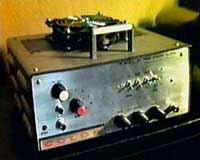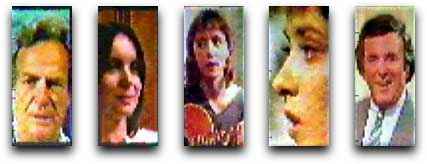30-line TV in the 1980s
Converting 625-line PAL colour to mechanical TV formats
 Many have assumed my restorations of original 30-line recordings are representative of what people saw at the time. This could not be further from the truth for the 30-line 12.5 frames per second broadcast format from 1929-1935. Even with restoration, the problems incurred by recording baseband video directly onto a Dictaphone-class aluminium disc recorder cannot be corrected completely.
Many have assumed my restorations of original 30-line recordings are representative of what people saw at the time. This could not be further from the truth for the 30-line 12.5 frames per second broadcast format from 1929-1935. Even with restoration, the problems incurred by recording baseband video directly onto a Dictaphone-class aluminium disc recorder cannot be corrected completely.
In 1987, after several years of saying that 30-line TV as broadcast would have been much better than my restored images, I built a digital scan converter to prove it. The device (on the left) took 625-line PAL and converted it to a variety of low definition TV standards in monochrome and colour. It was a modular design to allow any format to be tried out – though I built it for 64 line, 32 line and 30-line mono and colour and even 15-line colour (as per Baird’s 1928 experiments). Making it modular meant I seriously over-engineered the design, costing me over £400 in hardware components. The box you see is completely stuffed with analogue and digital CMOS and TTL hardware, which is why the fan is incongruously attached to the top.
Converting down from broadcast format gave me the benefit of having a broadcast TV quality source (excellent lighting and camera view) with professional action (plenty of movement). An amateur setup usually cannot address both those categories, nor arrange for coverage of the Olympic Games (as you’ll see below).
The main findings were that movement and recognition play a major part:
- There is a ‘super-resolution’ effect as objects move across the 30-line frame. This gives the effect of having more detail in the moving picture than in any still.
- With a human subject, the brain contributes substantial ‘recognition’ capability. At one nine-hundredth of original 625-line broadcast bandwidth (throwing away 99.9% of the information), the content that we see bizarrely appears to surpass the capabilities of the system.
- Conversely, with static subjects like landscape and buildings, the image often is completely unrecognisable – even in colour.
The examples below were all done in the 1980s. There is nothing more recent as not only is it all too simple nowadays to do this in software, but also the results below fully answered my questions on quality, and I moved on.
Examples of Frame Sequential Colour

© D F McLean 1990 from off-air broadcasts
In all instances, the television programme was stored on stereo audio-cassette tape – vision and sound taking each of the left and right channels of the tape. The still images above show how good low-definition colour can be. I’m sure you can recognise at least one – (Richard Feynman, Suzanne Vega, Terry Wogan). The still images and the video clips below all come from the audio-cassette tape played back through a custom interface onto my colour frame store (built in 1977-8).
Colour television from an audio cassette
Below is an example of frame sequential 30-line TV from a Wogan show in the 1980s. The original PAL colour video was converted by hardware into a cyclic 3-frame sequence of red, green then blue on consecutive frames, hence why there is colour break-up on movement. The colour image was reconstructed in the colour frame store, and converted back to PAL 625-line.
Olympic Gymnast on Beam
Whilst you can see that frame-sequential colour has a slow update rate and suffers from colour break-up, the straight monochrome image yields excellent quality in movement. This video clip from the 1988 Seoul Olympic Games featuring the absolutely stunning performance from an injured Aurelia Dobre from Romania gives an idea of why movement is so important. The off-tape original is 30lines 12.5 frames per second.
(The scan converter that generated the 30-line image had an additional facility for manually panning and/or zooming by a factor of 2, the scanned field within the high-definition field of view to capture both the detail and the movement)
Faces
This last example gives an idea of the added value of seeing the person talking. Considering the picture information is on one channel of an audio cassette with the audio we hear on the other channel, we can see there is a great benefit in seeing the play of expression on the face. The material is extracted from an LWT programme broadcast in 1987 featuring the visit to London by New York singer-songwriter Suzanne Vega. I’m showing this just to illustrate how good low definition video can be. Did we miss a trick when we binned 30-line TV in 1935?
Other Current Low Definition TV interest groups
Check out the NBTVA, the Narrow Band Television Association. Based in the UK, this club is devoted to all aspects of early television with emphasis on opto-mechanically scanned TV, based mostly on an enhanced version of Baird’s video standard.